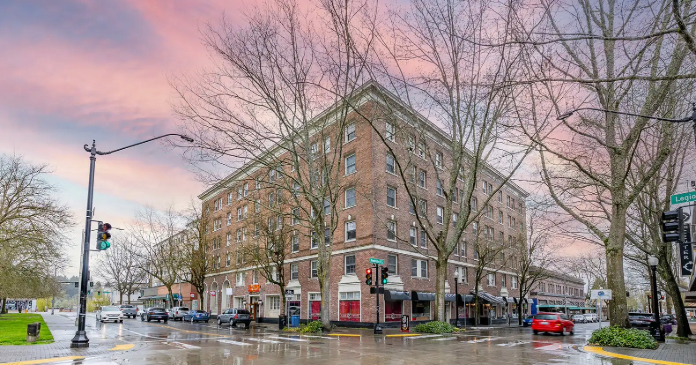Booker understands the need for housing affordable to low-income and special-needs residents, and to the workforce caught in the middle — those who earn too much to qualify for subsidies, but not enough to afford a mortgage or rent in the city. After all, he began his political life in Newark as a tenants’ rights activist and, while serving as Central Ward councilman, lived in Brick Towers, one of the largest affordable housing developments in that district.
In 2007, Booker joined with then-U.S. Sen. Barack Obama (D-ILL) and Jersey City Mayor Jerramiah Healy to support creation of a National Housing Trust Fund, to be funded by a percentage of the surplus profits of GSEs Fannie Mae and Freddie Mac, that would be used to help build 14,000 affordable housing units per year in cities across the country.
But by the time the Trust Fund was formalized on July 30 as part of the Housing and Economic Recovery Act of 2008 by former President George W. Bush, the GSEs were about to be placed into public conservator-ship.
Until they are profitable again and returned to private hands, any funding that may otherwise have made its way to the city to help offset the costs of building low-income housing has been suspended.
Meanwhile, since Booker came into office, the number of affordable housing units under construction in Newark has more than doubled to 326 units from 121 and the number of affordable units in the pipeline for development has more than tripled to 1,500.
“We are incorporating low-income housing into the fabric of our rebuilding efforts, including our downtown projects, such as the Richardson Lofts, the first new housing in the arena area that will have 80 percent market-rate and 20 percent affordable housing,” said Booker, referring to the $17 million adaptive reuse of a turn-of-the century jewelry factory, within walking distance of the New Jersey Performing Arts Center and the Prudential Center arena, as 67 apartments with LEED silver certification. Richardson Lofts, developed by locally based Newwork LLC, will begin leasing this fall.
But requiring an affordable component in market-rate residential during an economic crisis could be financially prohibitive for developers, said Meyer, who expects to revisit the requirement issue when the economy rebounds.
The bulk of Newark’s workforce and affordable housing development currently taking place is in its struggling inner city neighborhoods, through public/private partnerships and thanks to the generosity of philanthropists in partnership with non-profit organizations. Much of that development is green.
One block at a time
The inner-city neighborhoods are where Newark’s revitalization must begin, said John Abramo, Newark resident and executive director of the Greater Newark Housing Partnership Inc. (GNHP), an affiliate of the Housing Partnership Development Corporation (HPDC), a non-profit organization that has, for more than 25 years, served as New York City’s primary intermediary for the development of affordable workforce home-ownership housing.
“Newark at one time had a population of half a million, but that has fallen into the 250,000 range. Certainly the infrastructure is there for increased population, but there are not enough people living in Newark now to support the social services for the folks who need them.
There are not enough people to give business owners a reason to keep their shops open after five and six o’clock at night.
“Downtown development is fine. Putting up twenty- and thirty-story buildings is great to pull in anchor tenants. But Newark is having a hard time pulling in anchor tenants, partially because of the economy and partly because of the disposable income of the average person or household in Newark. Rebuilding in Newark will really come down to how well the affordable community is able to develop workforce housing in the neighborhoods and get people back on the streets, supporting the bodegas and having some disposable income to spend within the city limits,” he said.
Encouraged by the Booker administration’s policies and economic development efforts, Abramo and CEO Daniel Martin came to Newark in 2007, forming GNHP, with pro bono assistance from the Newark law firm of Buchanan, Ingersoll & Rooney, P.C. several months before the city instituted a program to rehabilitate vacant, abandoned and blighted properties in the West Ward.
The GNHP is providing the city with technical assistance and support for the disposition and redevelopment of city-owned properties within those vulnerable neighborhoods.
“Our role in Newark is no different than it is in New York City, where we act as intermediary with the public and private sectors to develop affordable housing,” said Martin.
Dirt is flying in Newark’s West Ward on a development project that will deliver five new homes and a 2,400 sq. ft. community garden across the street from an elementary school as the result of the West Ward Vacant and Abandoned Property Program, a pilot program involving 102 parcels of land, launched on the heels of the city’s first-ever Abandoned Property Ordinance.
Adopted in 2007 under New Jersey’s Abandoned Properties Rehabilitation Act, the ordinance enables the city to take appropriate action, including seizure of property, against privately owned residential or mixed-use buildings that have been vacant for more than six months and have unpaid taxes, or have been deemed blighted and a public safety hazard. Meyer expects the pilot program to expand to other wards throughout the city.
The city initiated the program by publishing an abandoned property list and notifying property owners of their buildings’ designation as abandoned. Newark officials then performed a preliminary survey, identifying 42 privately owned properties for redevelopment. Of those 42 properties, owners of 13 have already either renovated their buildings or initiated repairs, said Meyer.
“Our efforts in the West Ward have helped a number of owners understand the urgency of putting their properties back into productive use and the potential consequences of failing to do so,” said Meyer.
The GNHP also worked with the city, through Newark’s Neighborhood Stabilization Act, to catalogue all the vacant and abandoned sites in danger of foreclosure in the West Ward and can now look at those properties as potential for redevelopment, said Martin. Sites owned by the city and targeted for rehabilitation are sold to developers through an RFP process, or in rolling sales auctions.
“One of the Booker administration’s most important early development goals was to create a policy for selling city land that is transparent, fair and that provides the greatest benefits to Newark residents. Unlike past practices that allowed for-profit developers to purchase city land at nominal prices to make great profit, our policy requires that land be sold at a discount only when a developer agrees to meet important policy and economic development goals, such as local contracting and hiring of Newark residents for construction jobs,” said Meyer.
Because many of Newark’s residents did not benefit economically from all the development activity that occurred between 1995 and 2005, creating opportunities for Newark residents to increase their household income also is a top priority of the mayor, the city council and the administration.
“Most, if not all city land disposition contracts require that 30 to 40 percent of all onsite labor be local residents. The local hiring requirement for the West Ward Abandoned Properties Initiative is 70 percent,” said Abramo.
The West Ward RFP was broken into four categories corresponding to stages of the project — planning, new construction, site rehabilitation and oversight for the private property owners who responded positively to the city’s notification efforts. Only a handful of the 28 respondents to the RFP applied for all four of the stages or phases.
“There were roughly 20 applicants for the construction and rehab phase, and what the city ended up doing was choosing the one developer willing to include a number of other applicants,” said Martin.
The George Group LLC, headed by Newark native C. Tate George, was chosen as master developer by Newark’s evaluation team. The George Group then partnered with GNHP and they are working together with 13 small, local developers and contractors to complete the rehabilitation and construction on the properties. The partners’ roles range from construction management to co-developer to general contractor.
The $1.5 million project currently underway in the West Ward is the first phase of efforts that eventually will rehabilitate a 12-block area. Work will include gut rehabs of existing properties and new construction and possibly a variety of property types based on sites’ best and highest use in the market.
“The vast majority are one- to three-family home sites and a couple of mixed-use sites. Two lots fall on a commercial corner, so when we get to those we will look at retail on the ground floor and units above.
There is also a site in the heart of the footprint that looks like it could be a very nice 40- or 50-unit tax-credit rental, and we have another site — a former health facility — that would lend itself to a special-needs site,” said Martin.
To help make these projects feasible, the city is selling the land at reasonable rates. Prices for city-owned land in Newark have ranged from $1 per sq. ft. to fair-market value and 10 percent of all land sale proceeds are deposited into the Newark Affordable Housing Trust Fund. But Martin would like to see more subsidy dollars flow to the city.
“Right now we are using federal HOME money on the home-ownership projects. Also on the home-ownership side, the State of New Jersey through their CHOICE program makes subsidy available, but it is an extremely competitive subsidy and how much will be available for the West Ward and Newark is hard to say. Certainly if you are building a larger project that is utilizing tax credits, one of the difficulties is the gap. There is real need for tax credits right now. They were trading a couple of years ago, in 2005, at $0.98 on the dollar. They have dropped into the $0.72 range and the gap makes it very difficult to build any type of tax-credit rental. Under the stimulus package, there is a section to cover that gap, so that is a positive incentive on the rental side,” said Martin, who expects the West Ward revitalization will be complete by 2011 or 2012.















